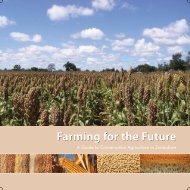Restoring the Soil - Canadian Foodgrains Bank
Restoring the Soil - Canadian Foodgrains Bank
Restoring the Soil - Canadian Foodgrains Bank
You also want an ePaper? Increase the reach of your titles
YUMPU automatically turns print PDFs into web optimized ePapers that Google loves.
Decision Tree Guide37or <strong>the</strong> gm/cc systems <strong>the</strong>y would most likely apply will keep <strong>the</strong> soil covered duringalmost all of <strong>the</strong> annual rainy season or seasons, go to #12. If <strong>the</strong> soil is at lessthan a 35% slope and will be well-covered during <strong>the</strong> rainy season, go to #12. Ifnei<strong>the</strong>r of <strong>the</strong>se conditions applies, go to #11.11. Contour hedgerows. To prevent or reduce water erosion, many farmers around<strong>the</strong> world are using contour hedgerows. This is a subject that could fill a book. Iwill mention just a few points that are very important and controversial amongsome practioners. First of all, ground cover is far more important than physicalbarriers in preventing water erosion, whe<strong>the</strong>r <strong>the</strong> barriers are contour hedgerows,rock walls, ditches, or whatever. If <strong>the</strong> gm/cc covers <strong>the</strong> ground well and <strong>the</strong> rainsare not too plentiful, farmers may not need hedgerows at all, even when <strong>the</strong> landis at a 40% slope. The ranges mentioned in #10 are applicable to most situations.Second, trees are not as effective as grass at holding <strong>the</strong> terrace face that maygradually build up (to as much as 75 cm), so probably <strong>the</strong> best over-all speciesfor hedgerows is Napier grass (Pennisetum purpureum), which is sometimes calledelephant grass. This species has a double function, as it holds <strong>the</strong> eroded soilvery well and provides a large amount of fodder for animals. If possible, use <strong>the</strong>varieties of napier grass that do not have small hairs on <strong>the</strong> leaves, as <strong>the</strong>y aremuch more palatable for animals and do not spread into farmers’ fields nearly asquickly. If grazing animals roam free during <strong>the</strong> dry season, <strong>the</strong> farmer who owns<strong>the</strong> hedgerows will receive no benefit from <strong>the</strong> napier grass as a good source offodder. A better choice in that case would be vetiver grass (Chrysopogon zizanioides).If <strong>the</strong> slope is less than 20% (so <strong>the</strong> terrace face will never get too high),<strong>the</strong> fields are at less than 1,000 m in elevation and <strong>the</strong> animals are under control,sugarcane is usually much more popular—but it will fall over if <strong>the</strong> terrace facegrows more than 25 centimetres (cm) in height.If farmers really want to plant non-grass crops in <strong>the</strong>ir hedgerows, such as pineapplesor fruit trees, a good option is to plant <strong>the</strong> grass and <strong>the</strong>n space <strong>the</strong> o<strong>the</strong>rcrops along <strong>the</strong> grass barrier. This would also apply to trees planted to createdispersed shade. If farmers want to plant o<strong>the</strong>r grasses, such as lemon grass or ashorter-stature grass among vegetables, <strong>the</strong>y can use <strong>the</strong>se instead of napier grass,at least on parts of <strong>the</strong>ir land.Hedgerows should not be planted at less than 12 m apart, because farmers willusually reject any shorter spacing. The rows can be as far as 20 m apart on lessinclined slopes. If <strong>the</strong> hedgerows are too far apart to catch all <strong>the</strong> soil, do notmove <strong>the</strong>m closer toge<strong>the</strong>r than 12 m; instead, find a way to cover <strong>the</strong> soil betterwith a gm/cc. Hedgerows should be laid out by <strong>the</strong> farmers using A-frame levels.Hedgerows can be planted after <strong>the</strong> gm/ccs or at <strong>the</strong> same time, except whereerosion is excessive. In <strong>the</strong> latter case, <strong>the</strong> gm/ccs will not provide any increasein crop yields until <strong>the</strong> hedgerows are developed enough to prevent <strong>the</strong> gm/ccs’organic matter from being washed down <strong>the</strong> hill. Go to #12.
















